 |
 |
 |
 |
| NORWOOD PARK IMPERIALS |
THE CADET ALUMNI SALUTE THE NORWOOD PARK IMPERIALS
|
| | 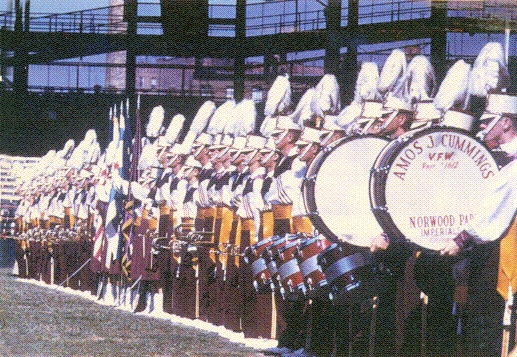 | |
| | Norwood Park 1958 at Ebbetts Field VFW National New York
| |
|
The Cadet Alumni use this page to salute friends from the past...corps that we respected and admired over our 74 year history for a variety of reasons. Some came to our aid when help was needed. Some were strong competitors whose values we shared. Some we came to know more personally because we were housed in their homes or vice versa, or shared housing sites. Some were friends made through prolonged contact during tours. Many times our corps became friends with another corps because individual friendships developed and spread to an unusual degree, often triggering personal visits during the off-season.
|
The Norwood Park Imperials are not a corps with whom we had extensive contact, but when we did the maroon co-mingled extensively. We liked and respected Norwood Park during our period of most regular interaction, the 1950s and early 1960s, in great part because during our occasional visits to the Midwest they always went out of their way to make us feel extremely welcome. Of course, wearing a maroon and white uniform is always a sure way to connect with the Cadets.
|
So this salute to Norwood Park is our thank you for those many times you went out of your way to say hello, and to shake our hands, and to offer praise and compliments that made us feel as though we were truly welcome in your world. You were always a more than worthy competitor on the field, and ambassadors of good will off the field. Your corps, though sadly no longer active in competition, is still remembered, respected, and admired by the Cadet Alumni fortunate enough to have shared the field of competition with you.
|
A good friend of The Cadets and Norwood Park Alumnus was kind enough to provide us with a history of this outstanding midwest competitor from the Chicago area. Our thanks to Dave Borck for the time and effort he spent in assembling this material for us.
|
NORWOOD PARK "IMPERIALS"
by Dave Borck
The Beginning
|
| | 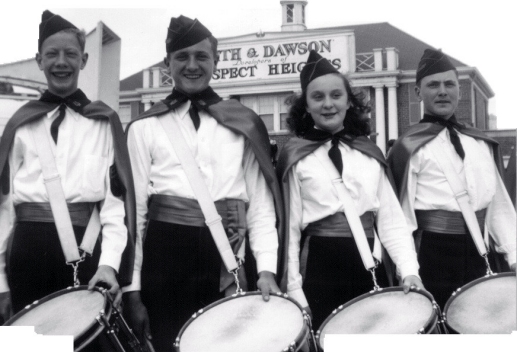 | |
| | Norwood Park snare drummers at a local appearance in 1943. Wayne Mounsey (member 1938-51),
still a very active alum, is shown at left.
| |
|
The Norwood Park Drum and Bugle Corps began in a small way in 1927 when a
group of neighborhood boys wanted to learn how to play drums. Their neighbor,
William (Willie) Widmayer, agreed to teach them at his home. Others joined and
soon they had a small drum and bugle corps, so some interested parents decided
to form a parent support group for the corps. The Norwood Park Drum and Bugle
Corps was officially formed. Original sponsors were the Parents Group and the
Norwood Park American Legion Post.
The Norwood Park Drum and Bugle Corps started just a few years before the
Holy Name Cadets. But, the Cadets entered field competition before we did. The
Cadets were competitively successful early on in their history, whereas
Norwood Park's progress could be better characterized as measured and steady! Both of
our corps quickly established shared traditions of spirit, pride and
excellence; which gave many of us in Norwood Park a special affinity for the
Cadets based on shared values! Sharing uniform colors seemed to further reinforce
those feelings.
The 1930s and 40s: From Local to National
During the late 30s, the Norwood Corps marched with about 100 members. They
placed well in local American Legion sponsored parade contests from 1936 -
1945.
The Corps remained a community-based parade corps, focused on local
appearances and community activities, until 1945, when field competition
beckoned. Fred Specht (from the National Champion Senior Corps, the Commonwealth Edison
"Knights of Light") was appointed the first military (marching) instructor to
teach the members a field drill, which included wheels and various other
complicated maneuvers. In 1947, Emmett Sarig, a music and band teacher at
Maine High School, joined the Corps as music instructor. The Corps' sound (and scores)
improved dramatically, bringing them their first State Championship. They
repeated in 1948 and 1949. In the 1949 season, Norwood went to their first National
Competition in Philadelphia. Competing against 40 corps, they placed 6th!
Norwood's founder, Willie Widmayer also started corps in other Chicago area
communities, 14 in all, but Norwood Park is the only one that survived into
the 1950s. He remained active with the Corps for many years after his retirement.
Alumnus Jack Bornhoeft reminds us: "Being a widower and having no children of
his own, Willie's joy was his extended family of young people in the Corps.
During WWII, Willie made a special effort to stay in touch with all of 'his
boys' who were in the service. He also made a special point of contacting them
when they returned home from overseas. We sure could use more people like him
today - an extraordinary man and a great friend."
Norwood started to compete against the Cadets in 1948; saw them in many
Nationals, and later Midwest regional competitions from that date forward.
We didn't beat them as often as we would have liked, but we were never
embarrassed to lose to them either. A win against the Cadets, however few and
far between, was something to be remembered. Shared on-the-field experiences
seemed to further increase our mutual respect.
The 1950s: The Corps Makes an Impression
Continuing with the same personnel in 1950, the Corps captured first place 7
times and won the State Championship for the 4th consecutive year. In 1951,
the Corps attended the National Competition in Miami, placing 4th.
Wayne Mounsey (snare drum, 1939 to 1951) writes about this period: "1950 was
one of the peak years for the Corps, as they won almost every one of the
contests they entered. Their fiercest competitor was the Austin Grenadiers.
The
State championships in 1950 brought about an unusual occurrence, as there were
two ties for the top spots: Norwood Park and the Austin Grenadiers for the
American Legion title and Logan Square and Gladstone Park for the Sons of the
American Legion title. All four corps had to repeat their entire 15-minute
drills. The tension was unbelievable. But Norwood and Logan Square were victorious."
Norwood Park continued national contention during the 50s and adopted the
name "Imperials" in 1955. During this time, they introduced some innovations
to drum corps, such as the Star/ Circle burst (1958), the use of dance moves
(Cha-Cha, 1959), and the use of "working" flags in the drill.
Our members were especially impressed by the efforts the (now GARFIELD, not
Holy Name) Cadets made to defend their AL title in Chicago (1958) .. on their
own! Seeing them take the field that day was awe-inspiring! A great
demonstration of pride and determination: to get "emergency" uniforms, borrow
equipment, get to Chicago and defend their title .. only to lose by a few
tenths!
Here is a comment from NP alum, Dave Borck (a drummer): The Cadets were
really great. While the music was great and the brass was excellent (marching
was
also solid), MY favorite element of the corps was the drum line! Their
drums had a GREAT sound, due to good tuning. The style of their arrangements
(use of snares and tenors, etc) was very different from the midwestern style. It
was also somewhat different from other eastern corps, such as BS and St.
Vinnies. The Cadet drum line also achieved a higher level of rudimental
drumming performance than most corps at that time."
1959 brought us to Minneapolis for Legion Nationals. Norwood had a strong
showing there, and a GREAT showing in an evening contest later in Stillwater,
MN. We competed at Legion Nationals just ahead of the Cadets. As they lined up
behind us, we noticed they had different uniforms. No longer the "Scout House"
type shorts, but not their traditional "West Point" uniforms either. As it
turns out, it was just an interim step .. as was their "rebuilding year". At
VFW in Detroit (1960), we saw the Cadets storm the field with their traditional
uniforms, and an expanded and very energetic corps!
Some contest results for this period:
1950 - Illinois State American Legion Champion
1951 - 4th at American Legion Nationals, Miami, score 86.61
1952 - 11th at American Legion Nationals, New York, score 84.00
1953 - 12th at American Legion Nationals, St. Louis, score 76.25
1954 - 14th at American Legion Nationals, Washington, score 73.48
1955 - Illinois State American Legion Champion,
7th at AL Nationals, Miami, score 86.98
1956 - Illinois State American Legion Champion,
2nd at VFW Nationals, Dallas, score 92.65
1957 - 6th at VFW Nationals, Miami, score 90.40
(4th at prelims, score 91.85)
1958 - 7th at VFW Nationals, New York, score 84.05
(tied with Boston Crusaders)
(6th at prelims, score 87.10);
7th at AL Nationals, Chicago, score 87.56
1959 - 6th at American Legion Nationals, Minneapolis, score 79.44
|
| | 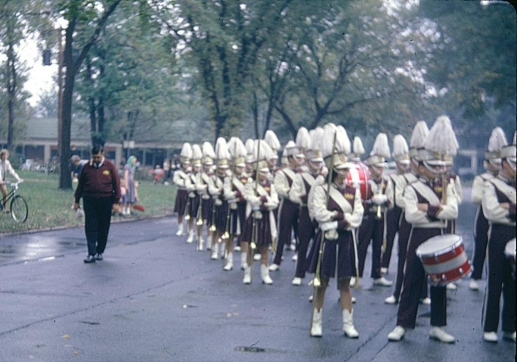 | |
| | Parade in 1964 .. Drum Corps Hall of Fame member Rick Maass (Left) Corps director
| |
|
The 1960s: Norwood Stays Competitive
In the early 1960s there was a new surge for the Corps. Stronger management
and better planning were introduced by Corps Manager Bob Briske, (who would
later go on to significant work with Drum Corps International-DCI) and
Business Manager Don Dennstaedt. Drum Corps Hall of Fame member Rick Maass followed as
Corps director from 1964 to 1967. Instruction staff included Rick Maass, Dick
Brown, Brian Pennington, Gary Czapinski and Bill Strauts.
The Cadets also visited the midwest as they made their way to Denver for AL
Nationals in 1961. A Norwood alumnus recently voiced his remembrance of that
event:
"One nice memory I have of the Cadets is when they came to Chicago to compete
in a couple of contests here. That was considered a very big event, especially
a top eastern corps like the Garfield Cadets. It added that much more to it.
They were invited to the Cavalier show at Maine East High School and also to
the contest in Woodstock. I remember there was a lot of anticipation on my
part of seeing them up close on the field and competing against them locally.
It was great to be part of that.
That period was still part of when the Eastern Corps had a DIFFERENT image,
like being in two different worlds."
In 1963, the Corps decided to forego national competition and instead attend
the prestigious National Dream Invitational contest in Bayonne, New Jersey.
They competed in a contest in Selden, Long Island, New York the day before,
then at the Dream contest on August 18, 1963.
Dave Borck adds: "It was a great thrill to be included in the Dream Contest,
along with the St. Kevin's Emerald Knights (Boston), the Blessed Sacrament
Golden Knights (Newark, New Jersey) and the Garfield Cadets (Garfield, New
Jersey). It was great fun to watch them and then to perform before the 26,000
fans in the stadium. They were really great drum corps fans too! They gave us a
great reception. But the tension was probably too much for us, and our show
was really 'off' due to nerves. Too bad that we were so new to this level of corps
activity!"
Unfortunately, because of the distance that separated us, we had few
opportunities for many significant social interactions and personal
relationships with Cadet members. But, this did happen in 1961 and 1963 to some degree. Some
very close friendships developed between Cadets and NP Imperials, some of
which continue to this very day.
|
| | 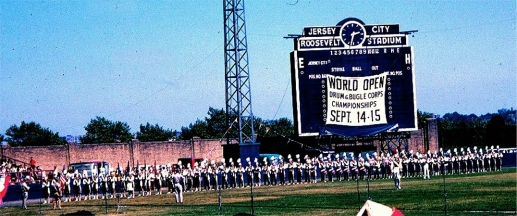 | |
| | Norwood Park on the starting line at Roosevelt Stadium .. The National Dream Invitational contest.
| |
|
Some contest results from this period:
1960 - 7th at VFW Nationals, Detroit, score 82.15
1961 - 3rd at American Legion Nationals, Denver, score 81.86
1962 - 7th at VFW Nationals, Minneapolis, score 80.95
(5th at prelims, score 85.72)
1963 - did not attend national competition, instead placed 4th at
The National Dream Invitational contest, Bayonne, NJ, score 75.80
1964 - 21st at VFW Nationals, Cleveland, score 78.40
1965 - 10th at VFW Nationals, Chicago, score 77.25
1966 - 11th at VFW Nationals, New York, score 79.40
(9th at prelims, score 84.35
1967 - 9th at VFW Nationals, New Orleans, score 75.70
1968 - 12th at VFW Nationals, Detroit, score 73.75
1969 - 21st at VFW Nationals, Philadelphia
The 1970s: Membership Declines
The Corps continued with its primary focus on community presence throughout
its existence. The Imperials never really tried to recruit members from other
areas, although some did join. Eventually, Corps membership declined in the
1970s. The Corps lost its state and national competitive presence, moving to
competition in the new DCI Division II.
While the Corps became smaller, it did not lose its community and family
focus. The Corps always was proud of its record and focus on stimulating
musical interest, military conduct, good and proper living and sportsmanship in the
youth of its community. American Legion sponsorship had changed in 1969 from
the Billy Caldwell Post to the Skokie American Legion Post, so the Corps was often
called the "Skokie Imperials" in the 1970s. During the 1970s, the Corps often
fielded just 45 to 50 members, but remained very musical and competitive for
its size. In 1978, membership rose back to 100 for a brief period.
|
| | 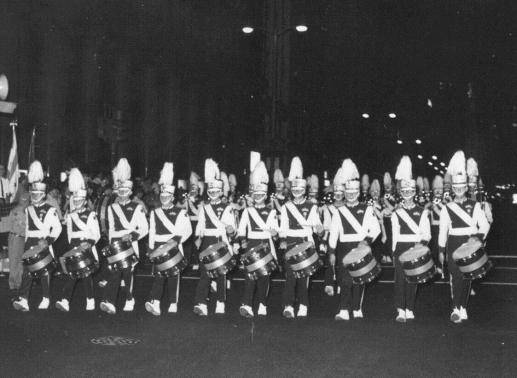 | |
| | Norwood Park 1965 VFW Nationals in Chicago.
| |
|
The 1980s: The Finish Line
Corps parents and interested supporters remained the primary source for Corps
management and direction. But, in the late 1970s and early 1980s, the Corps
fell on hard times. Many Corps presidents, managers and instructors worked
hard, in spite of increasing problems, to keep the Corps a valid and
functioning unit, but there just were not enough active supporters and volunteers any
more.
New Corps presidents and managers were generally inexperienced and they often
served as last minute fill-ins or replacements for people who burned out in
the disputes and overwork which became common. Leadership was no longer
continuous, sustained and strong. Financial and volunteer support was
uncertain.
The Corps had never developed a strong booster organization of parents,
alumni and other supporters. Maintaining Corps membership became difficult as
the finances dwindled and other corps raided the more experienced members.
Finally, the loss of membership, lack of ongoing support and the continuing
disputes about management caught up with the Corps. The Imperials became a
parade corps again in 1984 and the Cadet Corps was not fielded. In January,
1985 the Corps closed down it's marching program and cancelled all plans. It was
over now.
But the last Board of Directors had honesty and integrity, putting their
heads together to make sure that they sold everything possible to pay off the
Corps debts. One of them told us: "Debts were paid, even instructors, some of
whom were gracious enough to donate their salary to the corps. We paid some fifty
cents on the dollar, but at least they were paid. We sold off equipment, the
bus and truck, etc. The day we closed the books in 1987, we all had a clear
conscience, we paid off all debts."
And so, the Norwood Park Imperials, although dying, went out with class.
Thanks to the last Board for sticking it out and finishing it right.
The Corps had disbanded after 57 years of continuous operation. Until that
time in January 1985, the Norwood Park Imperials was widely known as the
oldest drum & bugle corps in continuous existence in the nation. Then, in 1987, the
Corps, after exhibiting its pride, honor and championship demeanor once again,
crossed the finish line for the last time.
Current times
The Imperials have not formed an alumni corps, but many Corps alums have
marched with the Chicago Royal-Airs alumni corps and, more recently, the
reformed Men of Brass. Alums gather periodically for reunions and attend some drum
corps shows together.
A recent comment from a NP alumnus about the 2007 Cadets:
"Garfield was always my favorite corps, and when I see the Cadet uniform
today, (exactly the way I remember it from the 60's), I still lose it. It's
quite a paradox that a corps that clings to tradition via the uniform, has thrown
tradition out the window during performance. That being said, I was at
Pasadena this past August for DCI and I saw the Cadets perform twice.. When they aren't
talking, the hornline plays MAGNIFICENTLY. Unbelievable talent! "
A favorite comment about the Cadets from our webmaster, when adding a link on
our website to the Holy Name Cadets alumni silte: "The Holy Name Cadets have
also been known as the Garfield Cadets and simply the Cadets, and many
Imperials alumni remember them as our friends that looked like us standing on
our heads." (You have to see the uniforms to appreciate this!)
Sadly, The Norwood Park Imperials now march only in our memories. (If the
Imperials WERE still alive today, they would be observing their 80th
anniversary this year... 2007!)
But, The Cadets live on: proudly displaying their heritage, pride and
excellence! We hope to see the maroon team going for many more years to come.
|
Intro by Dave Shaw text by Dave Borck
photos provided by Dave Borck.
|
 |
|
 |
 |
   |
 |
> |
